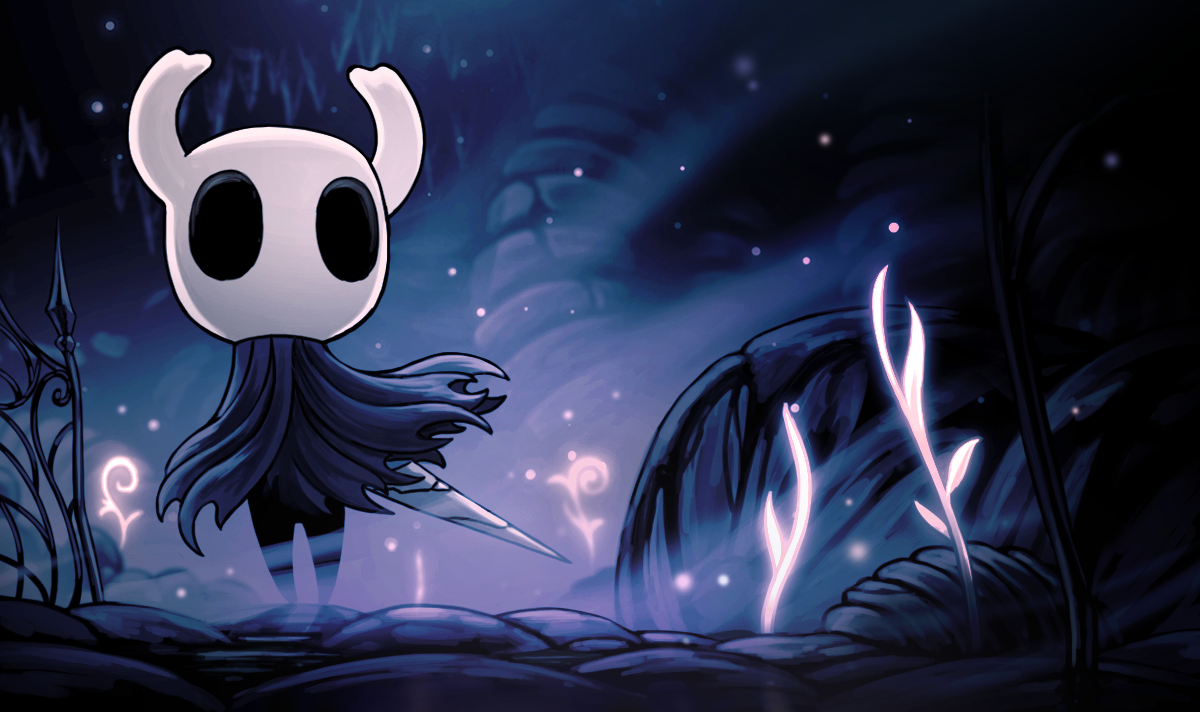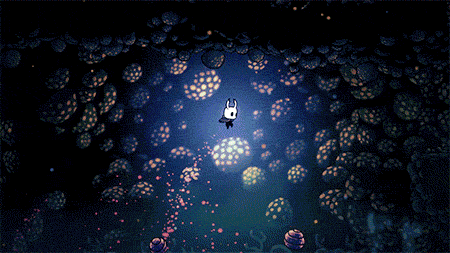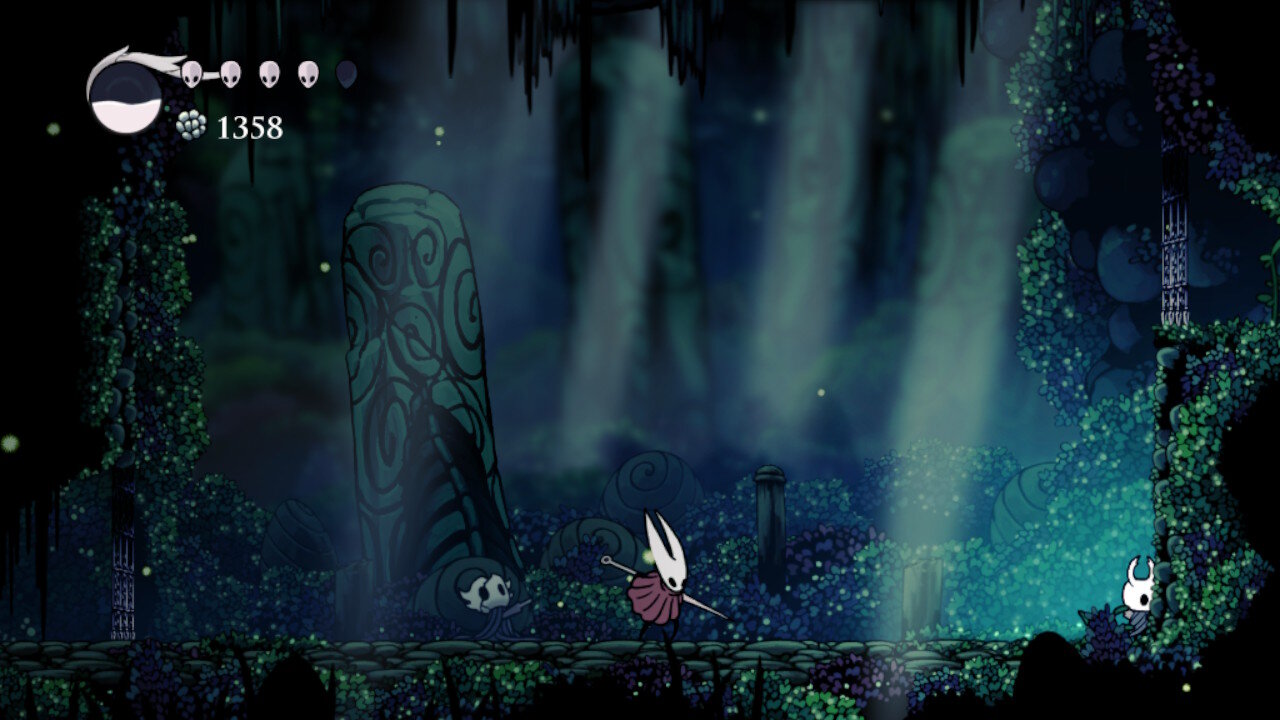Hollow Knight (Steam) Review
Metroidvania is a type of game that is derived from the Metroid series and the Castlevania series and one of the most prominent recent examples of this is the much-celebrated Hollow Knight. Hollow Knight is a side-scrolling action adventure full of darkness, mystery, sacrifice, and fulfillment made by Team Cherry, Ari Gibson, William Pellen, and David Kazi; the studio was founded in 2012 in Australia. Hollow Knight takes players through an incredible handcrafted world that is so hauntingly beautiful that it is hard to turn away from. All of this comes in cute and creepy bug form. Players take control of The Knight and dive deep into the shadows to find out the secrets of this thought-provoking title. Let’s break it down.
When first stepping into the game’s world, it’s immediately apparent of how dark the world is in Kings Pass coming into Dirtmouth itself. Coming into the world I quickly noticed just how smooth the controls were. Freeing myself from the tutorial zone put me in Dirtmouth, the city hub of the game. This is the highest point one can reach next to the Howling Cliffs, but this is the only real safe zone of this hostile land. Dirtmouth is full of NPCs that allow for narrative moments, the purchase of upgrades, rest, access the Stag Way, and plunge into the entrance of the Hallownest.
Hallownest is massive. I had no idea just how big it really was until I progressed into the game more and more. At first, I believed the game to be a short platforming game made by an indie studio I had never heard of before, the type of thing that often comes up in gaming and can be typically finished in a weekend. After I began to play in earnest, I kept thinking I surely was close to the end. Thirty-six hours later I have just completed the main storyline of the game in a blind run. I haven’t really scratched the surface of the four DLC adventures and I only have gotten one of several different endings. I cannot stress enough how wonderful my time with Hollow Knight has been.
For better or worse, I sunk a ton of time into Hollow Knight and I am not sad to see one minute of it gone.
Example of parallax in Unity used in Hollow Knight.
Hollow Knight has this wonderful art that is done in a hand-drawn style with hard outlined characters that nostalgically remind me of characters like Steam Boat Willy (the OG Mickey Mouse for those unaware). This game highlights how beautiful, dark, and empty feeling it is throughout almost every aspect of the visuals.
The journey through Hallownest takes The Knight to beautiful gardens, desolate landscapes, wind-torn cliffs, spider infested tunnels, ruined cities forever cast in rain, graves of those long passed, and even the abyss itself. Each and every one of these areas has this wonderful depth to them that is brought on with their parallax design.
For those who don’t know, parallax design like this is done by layering “levels” of art on top of one another. The term parallax scrolling was big in the SNES era of games and can be found in games like Super Castlevania and Yoshi’s Island. This allows for the darker artwork of the foreground structures to show in front of The Knight while traversing the Hallownest. This design choice makes the world come alive in a way that adds depth to everything and the environment becomes a larger part of the narrative, rather than just being another part of the game in a purely mechanical sense. This layering of the 2D art in Unity turns this 2D world turn into a rich, 3D-looking marvel.
There is a lot to say about height and depth in this game. As far as the full story of Hollow Knight goes, The Knight has climbed up from the abyss and reached the “surface” only to descend into the depths once more to unlock the secrets of Hollownest and free it from the infection that is threatening it. The adventure starts at the highest point in the game, The Howling Cliffs- Kings Pass, and descends through the lush environment of the world to the hollow and empty caverns of the Ancient Basin and into the void of the Abyss to find the true goal. Afterwards it directs the player to climb back up, nearly to the surface, so close I could taste it, only to have that feeling stripped away in mere moments.
This creates the odd sense of hitting rock-bottom. Yet, this makes The Knight stronger and the ascent becomes an empowerment moment for the player, using every skill learned through the descent, all to overcome the infection threatening Hallownest. Each level goes deeper into the world, revealing more and more about The Knight, what they are, their goals, and their motivations.
Each area has this magnificent sense of color, giving it the feeling that these areas are intertwined with the life force of this strange ecosystem. The wind-torn Howling Cliffs show the desolation outside of Hallownest, while the central and top portions show the life that continues to blossom there. The deeper one gets though, the color starts to get more faded, darker, turning into shades of grey, brown, and black. Life seems to be more scarce in the depths. Unlike the bright infection, these areas are void of life and light. There are lots of interpretations to be made about the way the world of Hollow Knight is organized and how the characters are portrayed. So many viewpoints that it’s impossible to cover them all in a single writing.
Diving deeper into the themes of light and darkness, the game has a large play on what is good and evil. The infection is this light that takes over everything and infects it. Meanwhile the darkness, or void, is where a lot of creation comes from, under the Pale King and the White Lady. The main character The Knight is one of so many vessels made from the brood of the Pale King and the White Lady, but The Knight is not the chosen one of this world.
Eventually, The Knight comes across lore that The Knight climbed out of the Abyss too late and was not chosen as the vessel for the Pale King. The Knight was literally created in the Void to combat the light of the infection. This brings on the perspective that some of the gloomy and darker parts of the world are not evil by nature. The bugs that have become husks of their former selves after giving into the infection are not the villains here. They are just being controlled by the infection, at least to some degree.
Using the Dream Nail weapon on some of the enemies shows that their minds retain their previous will. The guards in the City of Tears are revealed to constantly be thinking, “Defend the City” and that is what they continue to do when the The Knight arrives.
This incentives looking at things through different perspectives. In many Western stories, the heroes were often cowboys with a white hat and the one wearing black was usually the bad guy. In other cultures this trope could be flipped. Deeper still Westerns portrayed Native Americans as enemies to settlers, something that many Natives see as a false portrayal as people who were being brutally colonized.
Back to the hats, black is often associated with evil, but at the same time white is seen as a color of mourning and death. This is played with in Hollow Knight; the Void and the darkness become a neutral wellspring of potential to be molded and created from. More so, the color orange is the color of evil in Hollow Knight, representing creatures and places taken over by the infection.
Outside of the thematic and artistic aspects, Hollow Knight has wonderful and engaging gameplay from start to finish. The is very fluid movement and this game holds itself with any AAA release of the same type. It is quite unbelievable coming from an indie company for their first game. I was utterly blown away by the mechanics that really put how the game is played and approached in the hands of the player.
As stated in the above section about the art and 2D parallax effects, sometimes it can be hard to see if there is a spot that can actually be stood on, but this, to me, is part of the game’s intentional design. Putting myself in the character shoes I think “I’m not sure if this vine, or rock face can actually support me” and sometimes they don’t. Overall, Hollow Knight really makes sure players can tell the difference 90% of the time, while the other 10% is designed to be a risk management choice.
Further building on risk management as a part of player psychology, The Knight can use the nail weapon to bounce off of spikes and a few other hazards, but not thorns. This gives players a unique way to approach reaching upward areas and creates a bit of challenge as it puts The Knight in a moment of danger. Hollow Knight really lets players choose what sort of risks they’re willing to take or they can bypass with several upgrade options.
Hollow Knight can be challenging, but success is achievable at every point depending on the player’s skill, observation, and tenacity. The player always has the right tools to win, just some tools are harder to win with than others. The old phrase of a game being “Nintendo Hard” creates a sense of familiarity for me and Hollow Knight, bringing back memories of even games like Battle Toads. Hollow Knight is a game that demands attention and requires some practice.
While The Knight always has the bare essentials to succeed, it’s ultimately up to the player to face their own challenges and overcome in a way that suits them.
For those needing help, there are excellent guides out there for Hollow Knight but the feeling of overcoming danger alone is really satisfying.
Sometimes it takes choosing another path or approach to find that success but by not giving up, most players will reach their destination.
Visually, Hollow Knight is stunning. I cannot elaborate enough on how magnificent this game looks. Every piece of art that goes into this game boosts both the story and the atmosphere along every step of the journey. The atmosphere may look dark and gothic but it carries a sense of beauty.
Playing Hollow Knight is like watching a tragedy being performed on stage or on film, like a sunset or a dark sky pierced by starlight. Every element reinforces each moment. Running waters cut through the Royal Waterways, acid bubbles up in the Fungal Wastes, the descent into the Abyss starts to lack sound and color, steadily increasing a sense of dread with often only the sounds of shells crunching underfoot breaking the silence.
The score for Hollow Knight was done by Christopher Larkin, giving the game a truly dramatic effect on the emotions at play. Team Cherry really picked their composer well, as Larkin seems like the perfect artist for the job. There is nothing quite like staring down a threatening boss while the music drives the tension, putting The Knight in a fight for their life in a dark space, far way from anyone or anything they love.
All of these elements, art and color choice, gameplay and level design, music and sound, combine to make the player feel like they’re in a living, breathing world.
This feeling is akin to how some are able to imagine the warm ocean breeze with a touch of salt and humidity in the air through reading or watching a movie, mentally living in that moment, despite having never been to a beach.
Hollow Knight puts players directly in the shoes of The Knight, walking through an ever-expanding maze of a ruined world filled with terror and mystery.
Sound design furthers its excellence through careful attention to smaller details. Each action taken has delicate sounds behind them, creating a definitive feeling for hitting thorns or striking spikes of steel with the nail. The sound of the nail crunching each time it comes in contact with the chitin of an enemy has weight. Everything in Hollow Knight is there for a reason; it was created with purpose, even the smallest segments by comparison of the larger world. This drives the player to continue diving deeper, only to climb back up to seek rest, but always eager to dive back in.
There is a deep sense of lore in the game, carrying throughout Hallownest and it’s wide assortment of characters and enemies. These characters can be missed as they sometimes are not on the critical path. They offer characters to converse with to learn more about the game’s story, or offer a place to buy goods, or a way to travel faster. Parts of this process can feel tedious, leaving players to talk to the same characters over and over. Each time a new area is explored, the NPCs will usually have something more to say.
There are many sad and tragic tales shared by these characters with some speaking of hopes and dreams, literally in the case of the Hidden Dreams DLC. What really hit home for the lore and feelings being shared is the fact that these characters don’t speak in a human language that is coupled with deliberate body language. Each lore bit reveals the weight that Hallownest carries with and the secrets buried beneath. The emotions portrayed in these characters carries into the stellar boss battles, accentuated by particular music choices for maximum affect on the player’s thoughts.
Stepping back and considering Hollow Knight after finishing it, there are many things not expanded upon, at least not fully anyway. It takes some reading between the lines and lore collecting, pushing the player into certain thoughts that are open to interpretation and the influence of perspective.
On the surface, it’s easy to come to the conclusion of elements of light and dark being flipped. Light is evil here and darkness is the life of the world. This actually reminds me of the manga and anime Berserk, another piece of media I enjoy.
In the end of the game, to fight The Hollow Knight and The Radiance, The Knight doesn’t really fit the role they were created for, making them an unlikely hero. The Knight goes above and beyond their original calling, trading its Kingsoul for a Voidheart to end the bright infection of Radiance once and for all. The Knight gives up everything it could potentially become to save everyone else and end the cycle. Much like Berserk, Hollow Knight is truly a tragic story.
Adding to this, throughout the game The Knight crosses swords with Hornet. Come to find out, she wasn’t looking to stop The Knight out of malice, knowing that she cannot let another take the place of The Hollow Knight and continue the cycle. She wants to avoid needless sacrifice, ultimately helping The Knight to challenge The Radiance infection head-on, no matter the cost.
In the game’s final battles, the expected boss music of most games is replaced by a sad sense of refrain. This is emphasized by The Hollow Knight boss periodically stabbing itself instead of attack The Knight. The Hollow Knight is trying their best to fulfill the duty given, even when only hanging on by a thread.
The Hollow Knight can be a stand-in for falling into tradition and the cycles of destruction plaguing Hallownest.
Hollow Knight as a game is sad, deep, and extremely heavy. It’s a game that’s easy to fall in love with, much as I have. Tears could even be shed by the end.
This is a game worth returning to year after year, especially with additional modes like Steel Soul that adds even more frightful and harrowing challenges that even the most dexterous of players could struggle with.
When it comes to putting a score to this dark beauty of a game, I find Hollow Knight to be as close to perfection as some of the greatest games of all time, standing tall upon the shoulders of genre-defining titles, tall enough to leave its own legacy.










In this abbreviated horror FPS, Alien meets H.P. Lovecraft to create a unique and vague gaming experience. This is our review of Scorn.